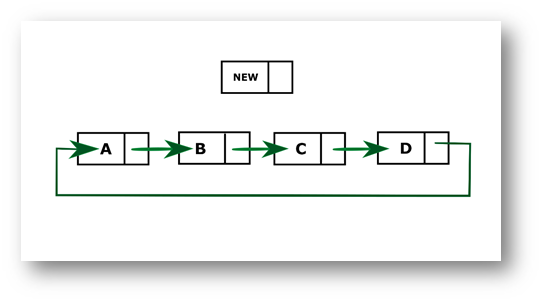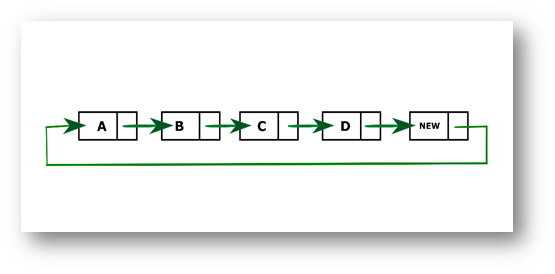📌 相关文章
- 数据结构示例-单向链表末端插入新节点(1)
- 数据结构示例-单向链表末端插入新节点
- 数据结构示例-循环链表的开头插入新节点
- 数据结构示例-循环链表的中间插入新节点(1)
- 数据结构示例-循环链表的中间插入新节点
- 数据结构-循环链表
- 数据结构-循环链表(1)
- 数据结构示例-创建n个节点的循环链表并计算节点数(1)
- 数据结构示例-创建n个节点的循环链表并计算节点数
- 数据结构示例-删除循环链表的开头节点
- 数据结构示例-删除循环链表的开头节点(1)
- 数据结构示例-删除循环链表中间节点
- 数据结构示例-删除循环链表中间节点(1)
- 数据结构示例-删除循环链表的末尾节点(1)
- 数据结构示例-删除循环链表的末尾节点
- 链表 |设置 2(插入节点)(1)
- 链表 |设置 2(插入节点)
- 数据结构示例-双向链表的开头插入新节点
- 数据结构示例-双向链表的开头插入新节点(1)
- 数据结构示例-双向链表的中间插入新节点
- 数据结构示例-双向链表的中间插入新节点(1)
- 数据结构示例-双向链表的末尾插入新节点
- 数据结构示例-双向链表的末尾插入新节点(1)
- 数据结构示例-循环链表的元素排序(1)
- 数据结构示例-循环链表的元素排序
- 循环链表的排序插入
- 数据结构示例-单向链表的中间插入新节点(1)
- 数据结构示例-单向链表的中间插入新节点
- 数据结构示例-创建并显示循环链表(1)
📜 数据结构示例-循环链表的末端插入新节点
📅 最后修改于: 2020-10-15 06:03:48 🧑 作者: Mango
问:程序在循环链表的末尾插入一个新节点。
说明
在此程序中,我们将创建一个循环链接列表,并将每个新节点插入列表的末尾。如果列表为空,则头和尾将指向新添加的节点。如果列表不为空,则新添加的节点将成为列表的新尾部。前一条尾巴将指向新节点作为其下一个节点。由于它是一个循环链表;新的尾巴将指向头部。换句话说,新节点将成为列表的最后一个节点(尾),而前一条尾将成为倒数第二个节点。

将新节点插入列表的末尾

New表示新添加的节点。 D是前一条尾巴。当将new添加到列表的末尾时,它将成为新的尾部,并且D将指向new。
算法
- 定义一个Node类,该类代表列表中的一个节点。它具有两个属性数据,下一个将指向下一个节点。
- 定义另一个用于创建循环链接列表的类,它具有两个节点:head和tail。它有两种方法:addAtEnd()和display()。
- addAtEnd()会将节点添加到列表的末尾:
- 它首先检查head是否为空(空列表),然后将节点插入为head。
- 头部和尾部都将指向新添加的节点。
- 如果列表不为空,则新添加的节点将成为新的尾部,而先前的尾部将指向新节点作为其下一个节点。新的尾巴将指向头部。
- display()将显示列表中存在的所有节点。
- 定义一个新节点“当前”,该节点将指向头部。
- 打印current.data,直到current再次指向head。
- 当前将在每次迭代中指向列表中的下一个节点。
示例:
Python
#Represents the node of list.
class Node:
def __init__(self,data):
self.data = data;
self.next = None;
class CreateList:
#Declaring head and tail pointer as null.
def __init__(self):
self.head = Node(None);
self.tail = Node(None);
self.head.next = self.tail;
self.tail.next = self.head;
#This function will add to the end of the list.
def addAtEnd(self,data):
newNode = Node(data);
#Checks if the list is empty.
if self.head.data is None:
#If list is empty, both head and tail would point to new node.
self.head = newNode;
self.tail = newNode;
newNode.next = self.head;
else:
#tail will point to new node.
self.tail.next = newNode;
#New node will become new tail.
self.tail = newNode;
#Since, it is circular linked list tail will point to head.
self.tail.next = self.head;
#Displays all the nodes in the list
def display(self):
current = self.head;
if self.head is None:
print("List is empty");
return;
else:
print("Adding nodes to the end of the list: ");
#Prints each node by incrementing pointer.
print(current.data),
while(current.next != self.head):
current = current.next;
print(current.data),
print("\n");
class CircularLinkedList:
cl = CreateList();
#Adding 1 to the list
cl.addAtEnd(1);
cl.display();
#Adding 2 to the list
cl.addAtEnd(2);
cl.display();
#Adding 3 to the list
cl.addAtEnd(3);
cl.display();
#Adding 4 to the list
cl.addAtEnd(4);
cl.display();
输出:
Adding nodes to the end of the list:
1
Adding nodes to the end of the list:
1 2
Adding nodes to the end of the list:
1 2 3
Adding nodes to the end of the list:
1 2 3 4
C
#include
#include
#include
//Represents the node of list.
struct node{
int data;
struct node *next;
};
//Declaring head and tail pointer as null.
struct node *head = NULL;
struct node *tail = NULL;
//This function will add the new node at the end of the list.
void addAtEnd(int data){
//Create new node
struct node *newNode = (struct node*)malloc(sizeof(struct node));
newNode->data = data;
//Checks if the list is empty.
if(head == NULL){
//If list is empty, both head and tail would point to new node.
head = newNode;
tail = newNode;
newNode->next = head;
}else {
//tail will point to new node.
tail->next = newNode;
//New node will become new tail.
tail = newNode;
//Since, it is circular linked list tail will point to head.
tail->next = head;
}
}
//This function will display the nodes of circular linked list
void display(){
struct node *current = head;
if(head == NULL){
printf("List is empty");
}
else{
printf("Adding nodes to the end of the list: \n");
do{
//Prints each node by incrementing pointer.
printf("%d ", current->data);
current = current->next;
}while(current != head);
printf("\n");
}
}
int main()
{
//Adding 1 to the list
addAtEnd(1);
display();
//Adding 2 to the list
addAtEnd(2);
display();
//Adding 3 to the list
addAtEnd(3);
display();
//Adding 4 to the list
addAtEnd(4);
display();
return 0;
}
输出:
Adding nodes to the end of the list:
1
Adding nodes to the end of the list:
1 2
Adding nodes to the end of the list:
1 2 3
Adding nodes to the end of the list:
1 2 3 4
JAVA
public class InsertAtEnd {
//Represents the node of list.
public class Node{
int data;
Node next;
public Node(int data) {
this.data = data;
}
}
//Declaring head and tail pointer as null.
public Node head = null;
public Node tail = null;
//This function will add the new node at the end of the list.
public void addAtEnd(int data){
//Create new node
Node newNode = new Node(data);
//Checks if the list is empty.
if(head == null) {
//If list is empty, both head and tail would point to new node.
head = newNode;
tail = newNode;
newNode.next = head;
}
else {
//tail will point to new node.
tail.next = newNode;
//New node will become new tail.
tail = newNode;
//Since, it is circular linked list tail will points to head.
tail.next = head;
}
}
//Displays all the nodes in the list
public void display() {
Node current = head;
if(head == null) {
System.out.println("List is empty");
}
else {
System.out.println("Adding nodes to the end of the list: ");
do{
//Prints each node by incrementing pointer.
System.out.print(" "+ current.data);
current = current.next;
}while(current != head);
System.out.println();
}
}
public static void main(String[] args) {
InsertAtEnd cl = new InsertAtEnd();
//Adding 1 to the list
cl.addAtEnd(1);
cl.display();
//Adding 2 to the list
cl.addAtEnd(2);
cl.display();
//Adding 3 to the list
cl.addAtEnd(3);
cl.display();
//Adding 4 to the list
cl.addAtEnd(4);
cl.display();
}
}
输出:
Adding nodes to the end of the list:
1
Adding nodes to the end of the list:
1 2
Adding nodes to the end of the list:
1 2 3
Adding nodes to the end of the list:
1 2 3 4
C#
using System;
namespace CircularLinkedList
{
public class Program
{
//Represents the node of list.
public class Node{
public T data;
public Node next;
public Node(T value) {
data = value;
next = null;
}
}
public class CreateList{
protected Node head = null;
protected Node tail = null;
//This function will add the new node at the end of the list.
public void addAtEnd(T data){
//Create new node
Node newNode = new Node(data);
//Checks if the list is empty.
if(head == null){
head = newNode;
tail = newNode;
newNode.next = head;
}else{
//tail will point to new node.
tail.next = newNode;
//New node will become new tail.
tail = newNode;
//Since, it is circular linked list tail will point to head.
tail.next = head;
}
}
//Displays all the nodes in the list
public void display(){
Node current = head;
if(head == null){
Console.WriteLine("List is empty");
}
else{
Console.WriteLine("Adding nodes to the end of the list: ");
do{
//Prints each node by incrementing pointer.
Console.Write(" "+ current.data);
current = current.next;
}while(current != head);
Console.WriteLine();
}
}
}
public static void Main()
{
CreateList cl = new CreateList();
//Adding 1 to the list
cl.addAtEnd(1);
cl.display();
//Adding 2 to the list
cl.addAtEnd(2);
cl.display();
//Adding 3 to the list
cl.addAtEnd(3);
cl.display();
//Adding 4 to the list
cl.addAtEnd(4);
cl.display();
}
}
}
输出:
Adding nodes to the end of the list:
1
Adding nodes to the end of the list:
1 2
Adding nodes to the end of the list:
1 2 3
Adding nodes to the end of the list:
1 2 3 4
PHP:
data = $data;
$this->next = NULL;
}
}
class CreateList{
//Declaring head and tail pointer as null.
private $head;
private $tail;
function __construct(){
$this->head = NULL;
$this->tail = NULL;
}
//This function will add the new node at the end of the list.
function addAtEnd($data){
//Create new node
$newNode = new Node($data);
//Checks if the list is empty.
if($this->head == NULL){
//If list is empty, both head and tail would point to new node.
$this->head = $newNode;
$this->tail = $newNode;
$newNode->next = $this->head;
}
else{
//tail will point to new node.
$this->tail->next = $newNode;
//New node will become new tail.
$this->tail = $newNode;
//Since, it is circular linked list tail will point to head.
$this->tail->next = $this->head;
}
}
//Displays all the nodes in the list
function display() {
$current = $this->head;
if($this->head == NULL) {
echo "List is empty";
}
else {
echo "Adding nodes to the end of the list:
";
do{
echo(" $current->data");
$current = $current->next;
}while($current != $this->head);
echo "
";
}
}
}
$cl = new CreateList();
//Adding 1 to the list
$cl->addAtEnd(1);
$cl->display();
//Adding 2 to the list
$cl->addAtEnd(2);
$cl->display();
//Adding 3 to the list
$cl->addAtEnd(3);
$cl->display();
//Adding 4 to the list
$cl->addAtEnd(4);
$cl->display();
?>
输出:
Adding nodes to the end of the list:
1
Adding nodes to the end of the list:
1 2
Adding nodes to the end of the list:
1 2 3
Adding nodes to the end of the list:
1 2 3 4